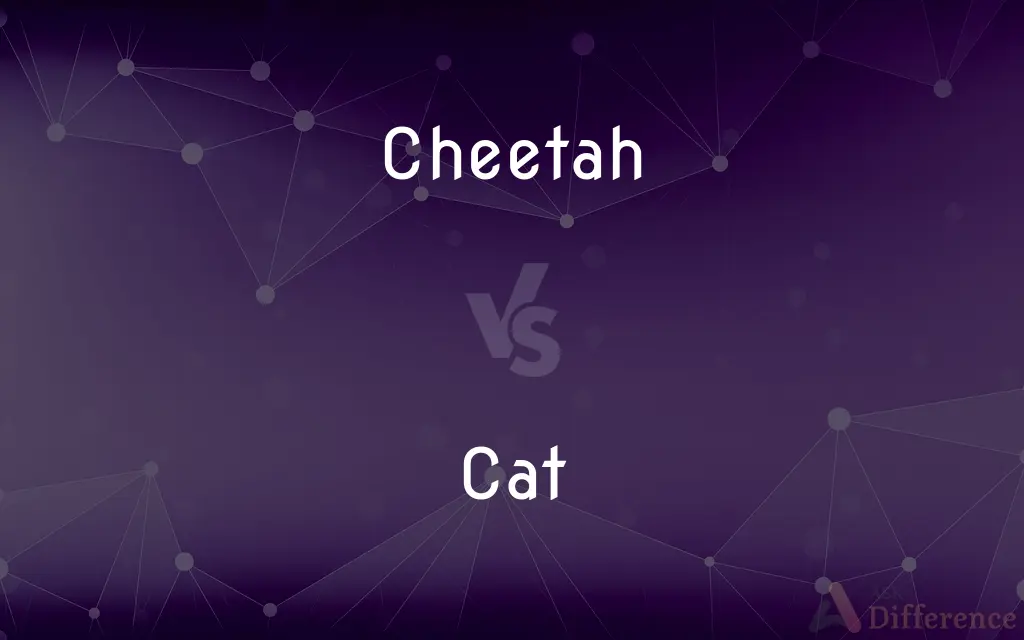Cheetah vs. Cat — What's the Difference?
By Urooj Arif & Fiza Rafique — Updated on May 4, 2024
Cheetahs are the fastest land animals, reaching speeds up to 75 mph in short bursts covering distances up to 1,500 ft, while domestic cats, much smaller and more agile, excel in short, sharp bursts of speed up to 30 mph.

Difference Between Cheetah and Cat
Table of Contents
ADVERTISEMENT
Key Differences
Cheetahs are known for their incredible speed and agility, adapted for hunting in the open savannah, while domestic cats are smaller predators, skilled in stalking and pouncing within more confined environments. Both species share a common ancestry but have evolved distinct physical and behavioral traits due to their differing habitats and lifestyles.
While cheetahs possess a lean build with long legs and a flexible spine to facilitate their high-speed chases, domestic cats have a more compact and muscular body that provides them the agility to make quick and sharp turns. This physical contrast underscores their respective predatory strategies: cheetahs rely on speed to catch fleet-footed prey like gazelles, whereas cats often catch smaller, more agile prey like birds and mice.
Cheetahs have a highly specialized respiratory system that allows for increased oxygen intake during sprints, supporting their high-speed pursuits. On the other hand, cats have a more typical respiratory system for a mammal of their size, sufficient for their bursts of speed over short distances. This difference highlights the adaptation of each species to their hunting techniques.
In terms of social behavior, cheetahs are somewhat unique among large cats, as they can exhibit both solitary and small group behaviors, often seen in female cheetahs with cubs or sibling groups. In contrast, domestic cats vary widely in their social structures, often influenced by their environment and upbringing, ranging from solitary to living in large, loosely organized groups, such as feral cat colonies.
Reproduction in cheetahs is notably challenging due to genetic bottlenecks and environmental pressures, making conservation efforts critical. Domestic cats, however, face fewer reproductive challenges and often deal with issues of overpopulation due to their ability to thrive in diverse environments and conditions.
ADVERTISEMENT
Comparison Chart
Speed
Up to 75 mph
Up to 30 mph
Build
Lean, long-legged
Compact, muscular
Hunting Strategy
Open space, high-speed pursuits
Confined space, stalking and pouncing
Respiratory System
Specialized for increased oxygen intake
Typical for short bursts
Social Behavior
Solitary or small groups
Solitary to large groups
Compare with Definitions
Cheetah
Characterized by a slender body and long legs.
The cheetah's build is optimized for explosive speed.
Cat
A small, typically furry, carnivorous mammal often kept as a pet.
The domestic cat curled up in the sunny corner of the room.
Cheetah
Native to parts of Africa and Central Iran.
The cheetah has adapted to a wide range of habitats across its range.
Cat
Can vary widely in size, color, and temperament.
Domestic cats can range from friendly and outgoing to shy and reserved.
Cheetah
Endangered species due to habitat loss and low genetic diversity.
Conservation programs are crucial for the cheetah's survival.
Cat
Often subject to overpopulation and stray issues.
Stray cats are common in many urban areas, leading to various challenges.
Cheetah
Capable of a unique high-speed chase strategy.
The cheetah uses incredible bursts of speed to catch its prey.
Cat
Exhibits a range of social behaviors influenced by environment.
Some domestic cats prefer solitude, while others enjoy companionship.
Cheetah
A large felid of the subfamily Felinae known for its speed.
The cheetah outpaced the gazelle in a swift chase.
Cat
Known for their agility and hunting ability.
The cat effortlessly climbed the tall tree to pursue a bird.
Cheetah
The cheetah (Acinonyx jubatus) is a large cat native to Africa and central Iran. It is the fastest land animal, estimated to be capable of running at 80 to 128 km/h (50 to 80 mph) with the fastest reliably recorded speeds being 93 and 98 km/h (58 and 61 mph), and as such has several adaptations for speed, including a light build, long thin legs and a long tail.
Cat
The cat (Felis catus) is a domestic species of small carnivorous mammal. It is the only domesticated species in the family Felidae and is often referred to as the domestic cat to distinguish it from the wild members of the family.
Cheetah
A long-legged, swift-running wild cat (Acinonyx jubatus) of Africa and southwest Asia, having tawny, black-spotted fur and nonretractile claws. The cheetah, the fastest animal on land, can run for short distances at about 96 kilometers (60 miles) per hour.
Cat
A small domesticated carnivorous mammal (Felis catus), kept as a pet and as catcher of vermin, and existing in a variety of breeds.
Cheetah
A distinctive member (Acinonyx jubatus) of the cat family, slightly smaller than the leopard, but with proportionately longer limbs and a smaller head; native to Africa and southeast Asia (where it is nearly extinct) and also credited with being the fastest terrestrial animal.
Cat
Any of various other carnivorous mammals of the family Felidae, including the lion, tiger, leopard, and lynx.
Cheetah
A species of leopard (Cynælurus jubatus) tamed and used for hunting in India. The woolly cheetah of South Africa is Cynælurus laneus. It runs very fast in short spurts while hunting.
Cat
(Informal) A woman who is regarded as spiteful.
Cheetah
Long-legged spotted cat of Africa and southwestern Asia having nonretractile claws; the swiftest mammal; can be trained to run down game
Cat
A person, especially a man.
Cat
A player or devotee of jazz music.
Cat
A cat-o'-nine-tails.
Cat
A catfish.
Cat
A cathead.
Cat
A device for raising an anchor to the cathead.
Cat
A catboat.
Cat
A catamaran.
Cat
To hoist an anchor to (the cathead).
Cat
An animal of the family Felidae:
Cat
A domesticated species (Felis catus) of feline animal, commonly kept as a house pet.
Cat
Any similar animal of the family Felidae, which includes lions, tigers, bobcats, leopards, cougars, cheetahs, caracals, lynxes, and other such non-domesticated species.
Cat
A person:
Cat
(offensive) A spiteful or angry woman.
Cat
An enthusiast or player of jazz.
Cat
(slang) A person (usually male).
Cat
(slang) A prostitute.
Cat
(nautical) A strong tackle used to hoist an anchor to the cathead of a ship.
Cat
Short form of cat-o'-nine-tails.
Cat
(archaic) A sturdy merchant sailing vessel now only in "catboat".
Cat
The game of "trap and ball" (also called "cat and dog").
Cat
The trap of the game of "trap and ball".
Cat
(archaic) The pointed piece of wood that is struck in the game of tipcat.
Cat
A double tripod (for holding a plate, etc.) with six feet, of which three rest on the ground, in whatever position it is placed.
Cat
(historical) A wheeled shelter, used in the Middle Ages as a siege weapon to allow assailants to approach enemy defences.
Cat
(computing) A program and command in Unix that reads one or more files and directs their content to the standard output.
Cat
(slang) A street name of the drug methcathinone.
Cat
Abbreviation of catapult
A carrier's bow cats
Cat
Abbreviation of catalytic converter
Cat
Abbreviation of catamaran
Cat
Abbreviation of category
Cat
Abbreviation of catfish
Cat
Abbreviation of caterpillar
Cat
(slang) Any of a variety of earth-moving machines. (from their manufacturer Caterpillar Inc.)
Cat
A ground vehicle which uses caterpillar tracks, especially tractors, trucks, minibuses, and snow groomers.
Cat
Abbreviation of computed axial tomographyOften used attributively, as in “CAT scan” or “CT scan”.
Cat
To hoist (the anchor) by its ring so that it hangs at the cathead.
Cat
To flog with a cat-o'-nine-tails.
Cat
(slang) To vomit.
Cat
To go wandering at night.
Cat
To gossip in a catty manner.
Cat
To apply the cat command to (one or more files).
Cat
To dump large amounts of data on (an unprepared target), usually with no intention of browsing it carefully.
Cat
Catastrophic; terrible, disastrous.
The weather was cat, so they returned home early.
Cat
Any animal belonging to the natural family Felidae, and in particular to the various species of the genera Felis, Panthera, and Lynx. The domestic cat is Felis domestica. The European wild cat (Felis catus) is much larger than the domestic cat. In the United States the name wild cat is commonly applied to the bay lynx (Lynx rufus). The larger felines, such as the lion, tiger, leopard, and cougar, are often referred to as cats, and sometimes as big cats. See Wild cat, and Tiger cat.
Laying aside their often rancorous debate over how best to preserve the Florida panther, state and federal wildlife officials, environmentalists, and independent scientists endorsed the proposal, and in 1995 the eight cats [female Texas cougars] were brought from Texas and released. . . . Uprooted from the arid hills of West Texas, three of the imports have died, but the remaining five adapted to swamp life and have each given birth to at least one litter of kittens.
Cat
A strong vessel with a narrow stern, projecting quarters, and deep waist. It is employed in the coal and timber trade.
Cat
A double tripod (for holding a plate, etc.), having six feet, of which three rest on the ground, in whatever position it is placed.
Cat
An old game;
Cat
Same as cat o' nine tails; as, British sailors feared the cat.
Cat
A catamaran.
Cat
To bring to the cathead; as, to cat an anchor. See Anchor.
Cat
Feline mammal usually having thick soft fur and being unable to roar; domestic cats; wildcats
Cat
An informal term for a youth or man;
A nice guy
The guy's only doing it for some doll
Cat
A spiteful woman gossip;
What a cat she is!
Cat
A whip with nine knotted cords;
British sailors feared the cat
Cat
A large vehicle that is driven by caterpillar tracks; frequently used for moving earth in construction and farm work
Cat
Any of several large cats typically able to roar and living in the wild
Cat
A method of examining body organs by scanning them with X rays and using a computer to construct a series of cross-sectional scans along a single axis
Cat
Beat with a cat-o'-nine-tails
Cat
Eject the contents of the stomach through the mouth;
After drinking too much, the students vomited
He purged continuously
The patient regurgitated the food we gave him last night
Common Curiosities
What are the conservation statuses of cheetahs and domestic cats?
Cheetahs are considered vulnerable and endangered in some areas, while domestic cats are widespread and often face overpopulation.
What is the top speed of a cheetah compared to a domestic cat?
A cheetah can reach speeds up to 75 mph, whereas a domestic cat's top speed is about 30 mph.
How do the reproductive challenges of cheetahs compare to those of domestic cats?
Cheetahs face significant reproductive challenges and genetic issues, while domestic cats breed more easily and often have issues with overpopulation.
What adaptations do cheetahs have for their high-speed chases?
Cheetahs have adaptations like a specialized respiratory system, long legs, and a flexible spine.
Can cheetahs climb trees like domestic cats?
Cheetahs are not typically tree climbers due to their build, unlike domestic cats, which are excellent climbers.
How do domestic cats impact local wildlife?
Domestic cats can significantly impact local wildlife, especially as predators of birds and small mammals.
How does the social behavior of a cheetah differ from that of a domestic cat?
Cheetahs may form small, cooperative groups, whereas domestic cats can live solitarily or in large social groups depending on their environment.
What types of environments do domestic cats adapt to?
Domestic cats are highly adaptable, thriving in urban, rural, and wild environments.
What are the major threats to the survival of cheetahs?
Major threats include habitat loss, human-wildlife conflict, and low genetic diversity.
How do the hunting strategies of cheetahs and cats differ?
Cheetahs hunt in open spaces using high-speed chases, while domestic cats use stealth and agility in confined spaces.
Do cheetahs make good pets like domestic cats?
Cheetahs are wild animals and do not make suitable pets, unlike domestic cats, which are ideal household companions.
How do the lifespans of cheetahs and domestic cats compare?
Cheetahs typically live 10-12 years in the wild, while domestic cats can live 15-20 years under optimal conditions.
Are cheetahs as trainable as domestic cats?
Cheetahs can be trained in captive environments, but they are not as adaptable or trainable as domestic cats.
Are cheetahs affected by human activities?
Yes, cheetahs are greatly affected by human expansion, habitat destruction, and conflicts with livestock.
What role do cheetahs and domestic cats play in their ecosystems?
Cheetahs help control prey populations like gazelles, whereas domestic cats can affect populations of small terrestrial wildlife.
Share Your Discovery

Previous Comparison
Cargo vs. Payload
Next Comparison
Crotchet vs. QuaverAuthor Spotlight
Written by
Urooj ArifUrooj is a skilled content writer at Ask Difference, known for her exceptional ability to simplify complex topics into engaging and informative content. With a passion for research and a flair for clear, concise writing, she consistently delivers articles that resonate with our diverse audience.
Co-written by
Fiza RafiqueFiza Rafique is a skilled content writer at AskDifference.com, where she meticulously refines and enhances written pieces. Drawing from her vast editorial expertise, Fiza ensures clarity, accuracy, and precision in every article. Passionate about language, she continually seeks to elevate the quality of content for readers worldwide.
















































